Ditapis dengan
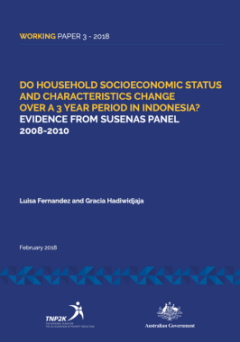
Do Household Socioeconomic Status And Characteristics Change Over A 3 Year Pe…
Database used to target social programs in Indonesia was updated every three years. Exclusion error and poverty dynamics in Indonesia have raised the question whether updating is required within that three year period. In this paper, we assess this issue by employing Susenas panel data to track changes in household characteristics and consumption mobility within three years. We find that househ…
- Edisi
- Working Paper 3 - 2018
- ISBN/ISSN
- -
- Deskripsi Fisik
- PDF, 34 Halaman
- Judul Seri
- Working Paper
- No. Panggil
- 330.9598 FER.D
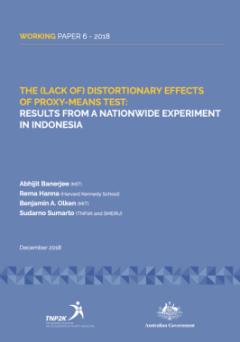
The (Lack Of) Distortionary Effects Of Proxy-Means Test:Results From A Nation…
Many developing country governments determine eligibility for anti-poverty programs using censuses of household assets. Does this distort subsequent reporting of, or actual purchases of, those assets? We ran a nationwide experiment in Indonesia where, in randomly selected provinces, the government added questions on flat-screen televisions and cell-phone SIM cards to the targeting census admini…
- Edisi
- Woking Paper 6 - 2018
- ISBN/ISSN
- -
- Deskripsi Fisik
- PDF, 36 Halaman
- Judul Seri
- Working Paper
- No. Panggil
- 330.9598 BAN.T
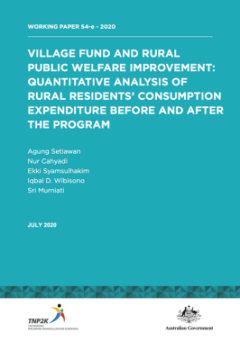
Village Fund And Rural Public Welfare Improvement: Quantitative Analysis of R…
The main finding of this study indicates that the Village Fund program has caused an increase in rural residents’ per capita expenditure. This study also finds that the magnitude of this increase in per capita expenditure varies by regional characteristics. Firstly, per capita expenditure in areas having good infrastructure is higher compared to per capita expenditure in areas having poorer i…
- Edisi
- Working Paper 54-e - 2020
- ISBN/ISSN
- -
- Deskripsi Fisik
- PDF, 20 Halaman
- Judul Seri
- Working Paper
- No. Panggil
- 307.72 SET. V
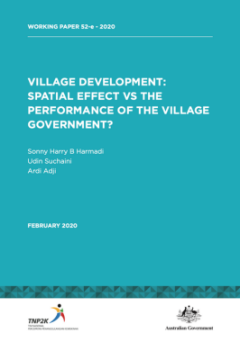
Village Development: Spatial Effect Vs The Performance Of The Village Governm…
Village funding in the amount of Rp 257.2 trillion in the past five years (2015-2019) uses a scheme that shares funding equitably. This is evident from the proportion of village funds (90 percent) that was divided equally (2015-2017) (Ministry of Finance, November 2017). This study aims to prove that the achievements of village development are not only due to the impact of the Village Fund Prog…
- Edisi
- Working Paper 52-e - 2020
- ISBN/ISSN
- -
- Deskripsi Fisik
- PDF, 38 Halaman
- Judul Seri
- Working Paper
- No. Panggil
- 307.72 HAR. V
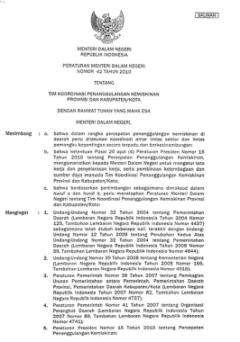
Peraturan Menteri Dalam Negeri Nomor 42 Tahun 2010 Tentang Tim Koordinasi Pen…
- Edisi
- 42 2010
- ISBN/ISSN
- -
- Deskripsi Fisik
- PDF, 17 Halaman
- Judul Seri
- Peraturan Perundangan
- No. Panggil
- 348.598 KEM.P
- Edisi
- 42 2010
- ISBN/ISSN
- -
- Deskripsi Fisik
- PDF, 17 Halaman
- Judul Seri
- Peraturan Perundangan
- No. Panggil
- 348.598 KEM.P
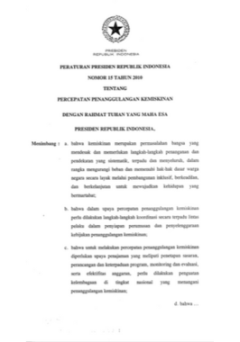
Peraturan Presiden Republik Indonesia Nomor 15 Tahun 2010 Tentang Percepatan …
- Edisi
- -
- ISBN/ISSN
- -
- Deskripsi Fisik
- PDF, 21 Halaman
- Judul Seri
- Peraturan Perundangan
- No. Panggil
- 348.598 PRE. P
- Edisi
- -
- ISBN/ISSN
- -
- Deskripsi Fisik
- PDF, 21 Halaman
- Judul Seri
- Peraturan Perundangan
- No. Panggil
- 348.598 PRE. P
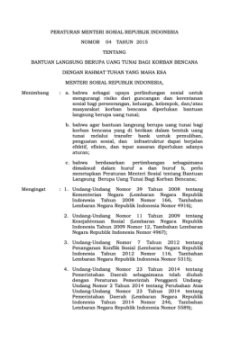
Peraturan Menteri Sosial Republik Indonesia Nomor 04 Tahun 2015 Tentang Ban…
- Edisi
- NOMOR 04 TAHUN 2015
- ISBN/ISSN
- -
- Deskripsi Fisik
- PDF, 20 Halaman
- Judul Seri
- Peraturan Perundangan
- No. Panggil
- 348.598 KEM.B
- Edisi
- NOMOR 04 TAHUN 2015
- ISBN/ISSN
- -
- Deskripsi Fisik
- PDF, 20 Halaman
- Judul Seri
- Peraturan Perundangan
- No. Panggil
- 348.598 KEM.B

Peraturan Presiden Republik Indonesia Nomor 96 Tahun 2015 Tentang Perubahan A…
- Edisi
- NOMOR 96 TAHUN 2015
- ISBN/ISSN
- -
- Deskripsi Fisik
- PDF, 6 Halaman
- Judul Seri
- Peraturan Perundangan
- No. Panggil
- 348.598 PRE.P
- Edisi
- NOMOR 96 TAHUN 2015
- ISBN/ISSN
- -
- Deskripsi Fisik
- PDF, 6 Halaman
- Judul Seri
- Peraturan Perundangan
- No. Panggil
- 348.598 PRE.P
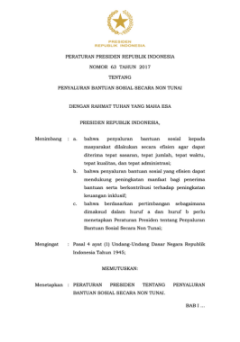
Peraturan Presiden Republik Indonesia Nomor 63 Tahun 2017 Tentang Penyaluran …
- Edisi
- 63 2017
- ISBN/ISSN
- -
- Deskripsi Fisik
- PDF, 14 Halaman
- Judul Seri
- Peraturan Perundangan
- No. Panggil
- 348.598 PRE.P
- Edisi
- 63 2017
- ISBN/ISSN
- -
- Deskripsi Fisik
- PDF, 14 Halaman
- Judul Seri
- Peraturan Perundangan
- No. Panggil
- 348.598 PRE.P
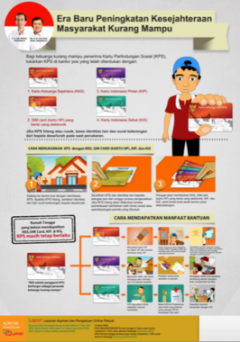
Era Baru Peningkatan Kesejahteraan Masyarakat Kurang Mampu
- Edisi
- -
- ISBN/ISSN
- -
- Deskripsi Fisik
- PDF, 1 Halaman
- Judul Seri
- Info Grafis
- No. Panggil
- 362.5 TNP. E
- Edisi
- -
- ISBN/ISSN
- -
- Deskripsi Fisik
- PDF, 1 Halaman
- Judul Seri
- Info Grafis
- No. Panggil
- 362.5 TNP. E
 Karya Umum
Karya Umum  Filsafat
Filsafat  Agama
Agama  Ilmu-ilmu Sosial
Ilmu-ilmu Sosial  Bahasa
Bahasa  Ilmu-ilmu Murni
Ilmu-ilmu Murni  Ilmu-ilmu Terapan
Ilmu-ilmu Terapan  Kesenian, Hiburan, dan Olahraga
Kesenian, Hiburan, dan Olahraga  Kesusastraan
Kesusastraan  Geografi dan Sejarah
Geografi dan Sejarah